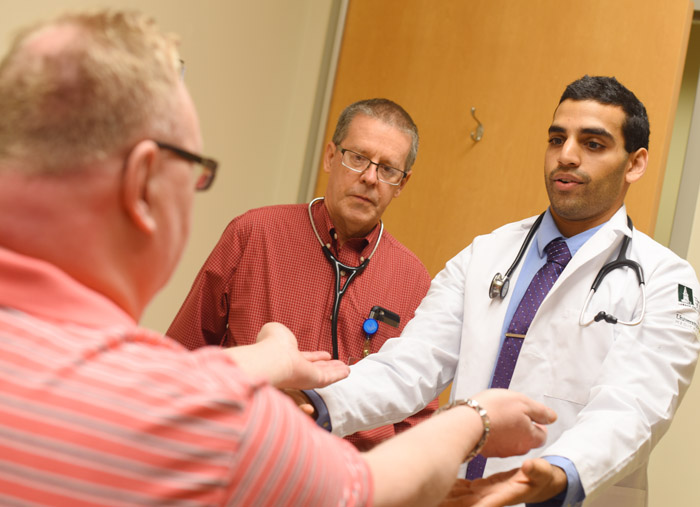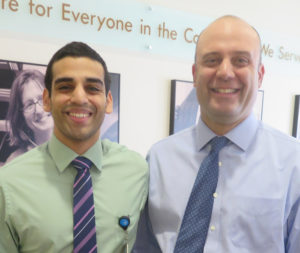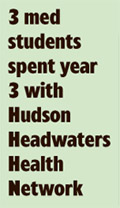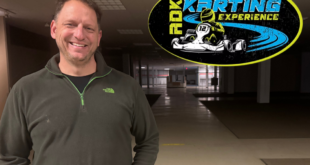By Mark Frost, Chronicle Editor
Three University of Vermont Medical School students are wrapping up their third year, spent in a pilot program with Hudson Headwaters Health Network based in Queensbury.
“I love it. I would stay if I could,” Sunit Misra, 26, one of the students, told The Chronicle Monday. “When I came in, I wanted to be an eye surgeon. Now I want to do family medicine.”
That’s part of Hudson Headwaters’ hope, even better if they settle here, says Dr. Tucker Slingerland, the organization’s CEO as well as a practicing physician.
He says part of the thrust of the program is “a commitment to try to address work force needs. We feel if we get them out of the tertiary settings, they’ll recognize real value in living in communities like Glens Falls.”
Mr. Misra, who said he comes from a suburban California community with “over a million residents,” remarks, “I feel a lot more at home here than I do in Vermont,” where he lived twice as long.
Hudson Headwaters left nothing to chance. “We wanted to make sure their whole experience is orchestrated,” said Jane Morrissey, Hudson Headwaters’s Coordinator of Medical Education.”
That extended to getting the medical students into cross-country skiing and the civic group Friends of Coles Woods.
Each of the three current UVM medical students also took on a community project. Mr. Misra went into the Warrensburg School and worked with elementary students two hours a month after school.
The focus is on food. “Nutrition is something I’m interested in,” he said. He aimed to “get them more engaged with food. The more you know about it, the more you care about it.” He said he’d “have them smell and taste foods and tell me what they like and what they don’t like.”
He found that some students liked plain Greek yogurt with fresh strawberries. “Some kids liked spinach smoothies; some kids said it tasted like puke.”
And what did Mr. Misra learn? “PowerPoints do not work with five-year-olds.”
On Wednesday, Feb. 7, the HHHN-UVM program — officially the “Longitudinal Integrated Clerkship” (LIC) — celebrates its first year with a banquet at the Queensbury Hotel. Mr. Misra’s students will do a presentation about the food program.

But medical education remains the principal focus of the students and HHHN. It’s overseen locally by Dr. Colleen Quinn, working in conjunction with the medical school.
Mr. Misra noted that in the first two years of medical school, “we read about patients.” He said UVM has “a nice simulation lab” and the students gain experience treating “professional patients.”
Here, he was face to face with real ones — “meeting the patients, building a relationship and following them.”
He said, “You’re often the first one in the room to talk to the patient….When they’re in the hospital, eight, nine days, I’m there every single day. When you see them on day four, day five, day six, you really start to appreciate what they’re going through.”
Dr. Slingerland said HHHN gains, too, because the student gleans more than a doctor typically gains from seeing charts. The student “really becomes an asset.”
Mrs. Morrissey stressed the buy-in from Glens Falls Hospital and area physicians.
“There’s no way Hudson Headwaters could have done this independently. The hospital is really key for this….The students have received such a warm welcome at the hospital and in the community.”
She said the local physicians “get a lot of satisfaction out of it. It’s a nice component of their day.”
Dr. Slingerland suggests that the students also gain because rather than concentrated six-week blocks where they “just do obstetrics, just do surgery,” Hudson Headwaters was wide open. Instead of knowing it’s a neurology issue, says Dr. Slingerland, “it could be anything.”
“Retention is stronger when different disciplines are presented together,” Dr. Slingerland says the research indicates.
Mrs. Morrissey said the students were taking the same exams that their schoolmates back in Burlington were taking — “consistently outscoring them.”
Mr. Misra said the buzz about the program on campus is positive, too. “I can’t tell you how many times I got stopped by first years,” when he was back in Vermont.
The end result? For the program’s second year, “we actually had 11 students come in a van to check it out,” said Mrs. Morrissey, and it was competitive. Four students were selected for the next go.
HHHN houses them at the new 14 Hudson apartments, which is convenient for being next-door to the hospital, so students can be on call there, and also because it connects them to “the energy” of downtown Glens Falls,” said Dr. Slingerland.

at the University of Vermont’s
Larner College of Medicine.
D. Tucker Slingerland, M.D. is
Chief Executive Officer of
Hudson Headwaters Health Network.
Chronicle photo/Mark Frost
Fourth-year medical students go do residencies, also a competitive selection process that Mr. Misra is now undertaking.
Dr. Slingerland says Hudson Headwaters’ goal is to have residencies done here.
“We definitely regard that as the missing link,” he said. “Today we’re not training residents…That’s a key piece of the training program that we have to figure out how to bring to Glens Falls.”
He calls it also key to physician recruitment. “People are more likely to settle down in the place where they train.”
Dr. Slingerland noted that Champlain Valley Physicians Hospital in Plattsburgh — which is now under the umbrella of the University of Vermont Medical School — “has two residents” at Hudson Headwaters’s Champlain Health Center.
“We’re stepping into that next level,” says Dr. Slingerland, but he says “new programs are expensive to launch” and an accreditation process must be navigated.
Meanwhile, he notes, “We’ve been involved for decades” hosting earlier-year Albany Medical College students, besides the new program for UVM third-years.
Mr. Misra said, “The learning curve is steep” coming into a program like this one at Hudson Headwaters. “I kind of feel I’m better prepared” for what will come next.
Dr. Slingerland suggests this model is the future of medical education, and he says the experience Mr. Misra has had “could sort of change the course of his career and life.”
Copyright © 2018 Lone Oak Publishing Co., Inc. All Rights Reserved.
 Glens Falls Chronicle Serving the Glens Falls/Lake George region; Warren, Washington and northern Saratoga counties since 1980
Glens Falls Chronicle Serving the Glens Falls/Lake George region; Warren, Washington and northern Saratoga counties since 1980



